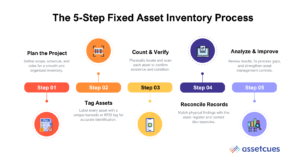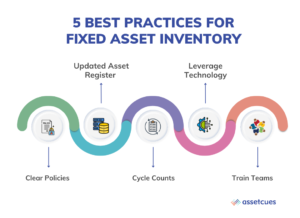Introduction
Why care about fixed asset inventory? Consider this: enterprises lose an average of $70,000 each year from poor asset tracking. Nearly 30% of information in the asset register may not match the physical reality. Inaccurate fixed asset records cause financial losses, compliance risks, and audit issues.
>>Try our Asset Verification Software today
Finance, accounting, and audit professionals in mid-to-large companies need clear asset visibility. Without it, organizations risk overpaying taxes or insurance on non-existent items and may even fail audits. Effective fixed asset inventory management ensures accurate tracking of assets, their locations, and current status. This clarity reduces financial errors and strengthens overall asset accountability.
What Is Fixed Asset Inventory? (Definition)
Fixed asset inventory means cataloging and verifying all long-term assets a business owns. It involves physically counting or scanning each item and aligning it with company records. This physical asset inventory process keeps asset data accurate, current, and fully reliable.
-
Tangible vs. Intangible Assets:
Fixed asset inventories primarily cover tangible assets such as buildings, machinery, and IT hardware. These assets support operations, depreciate over time, and require accurate tracking. While intangibles like patents or software are recorded, physical asset inventory focuses only on tangible assets.
-
Relation to Asset Register:
A fixed asset register is the central database containing all asset details and records. Conducting a fixed asset inventory verifies this register against real-world physical assets. This cross-check ensures accurate financial reporting by confirming the register truly mirrors reality.
-
Frequency:
Most businesses perform a fixed asset inventory annually, usually near fiscal year-end. Auditors and regulations often mandate at least one physical asset inventory each year. High-turnover or regulated industries may conduct semi-annual or quarterly cycle counts.
Don’t confuse fixed asset inventory with product inventory meant for sale or resale. Here, “inventory” means listing and verifying capital assets owned by the company. Like product checks confirm stock, fixed asset inventory audits assets currently in use.
To understand how asset management differs from inventory management, explore our glossary guide: Asset Management vs. Inventory Management.
Why Is Fixed Asset Inventory Important?
Conducting regular fixed asset inventories is critical for several reasons. It ensures financial accuracy, helps catch issues like ghost assets, prevents waste, and supports compliance. Here are some key benefits of proper fixed asset inventory management:
-
Ensure Financial Accuracy (Eliminate “Ghost Assets”):
Without regular verification, companies may retain “ghost assets” — items lost, stolen, or disposed of but still recorded. Research shows 15–30% of assets in many firms fall into this category. Removing such non-existent items ensures accurate records and prevents financial misstatements or fraud risks.
-
Cost Savings & Efficiency Gains:
Accurate fixed asset inventory records prevent wasteful spending and duplicate equipment purchases. They help reallocate underused assets, reducing unnecessary costs and insurance on idle items. Reliable records also streamline audits, lowering fees and internal labor through improved efficiency.
-
Theft Reduction & Asset Security:
When assets aren’t tracked, theft or misappropriation becomes far more likely. Regular physical asset inventory with barcoded or RFID-tagged items deters loss and flags missing assets quickly. Consistent tracking builds accountability, discouraging misuse and simplifying recovery of stolen assets.
-
Better Planning & Asset Lifecycle Management:
An accurate fixed asset inventory offers clear visibility into each asset’s condition and age. Consequently, management can plan timely repairs, replacements, or upgrades more efficiently. Moreover, with up-to-date data, companies can forecast budgets, prevent downtime, and optimize capital planning.
-
Compliance & Audit Readiness:
Accurate asset records are critical for financial reporting and compliance. Standards like U.S. GAAP and IFRS require verifying that fixed assets listed on balance sheets truly exist and are properly valued. Conducting a fixed asset inventory before year-end strengthens internal controls, supports frameworks like Sarbanes-Oxley, and prevents audit issues. Ultimately, maintaining an updated fixed asset inventory ensures accuracy, transparency, and audit readiness in financial reporting.
Explore the beginner’s guide to asset inventory systems >>
How to Conduct a Fixed Asset Inventory
So, how do you actually perform a fixed asset inventory in a large organization? Below is a step-by-step process to plan and execute a successful physical asset count:

-
Step 1: Plan the Inventory Project
Effective preparation ensures a smooth fixed asset inventory process. Start by defining the scope, timing, and team roles while planning around downtime. Document clear procedures, choose tools like mobile apps or scanners, and communicate schedules across departments early. Finally, clean asset data, tag new items, and gather essentials like RFID scanners and asset lists to enable efficient, accurate execution.
Read more about the fixed asset inventory process>>
-
Step 2: Update or Create Asset Tags for Identification
Before starting the count, ensure each asset has a unique label or ID. Verify all barcode or RFID tags are present, legible, and replace any damaged ones. Tag unmarked assets, update the system, and flag missing ones during verification. This upfront tagging step ensures every asset in the fixed asset inventory links to the register, making the physical asset inventory faster and more accurate.
-
Step 3: Conduct the Physical Inventory Count
Begin the physical audit by working location by location using your asset list. Then, scan each asset’s barcode or RFID tag to verify it, update locations, and record condition changes instantly. Next, document discrepancies, tag unlisted assets, and flag missing ones for follow-up. Finally, leveraging mobile devices or RFID scanners streamlines the fixed asset inventory process, improving accuracy and saving valuable audit time.
-
Step 4: Reconcile and Update Records
After completing the count, reconcile results with your asset register to ensure accuracy. Then, add newly found assets, update existing details, and remove missing ones with approval. Next, document all corrections in a reconciliation report reviewed by management or auditors. Ultimately, this keeps your fixed asset inventory accurate, removes ghost assets, and ensures reliable financial records.
-
Step 5: Analyze Results and Improve Processes
Use the inventory results to enhance your asset management process effectively. Then, analyze each discrepancy, identify its root cause, and resolve process gaps. Next, strengthen fixed asset policies by enforcing timely disposal reporting or implementing check-out logs. Ultimately, treat every fixed asset inventory as feedback to improve control, accuracy, and compliance.
Establish a continuous improvement plan by scheduling the next asset inventory within a year. Conduct mini-counts for high-risk assets between full audits to maintain accuracy. Share results with management to showcase value, such as cost savings or removed ghost assets. Ongoing refinement ensures smoother future inventories and reliable asset data management.
Best Practices for Effective Fixed Asset Inventory Management
We’ve covered the what, why, and how; now, let’s distill that into best practices to keep your fixed asset inventory accurate year-round. To begin with, these consistent habits transform a one-time inventory task into a sustainable, long-term program. Moreover, they help maintain control, accuracy, and compliance across your asset management process.

-
Establish Clear Policies & Procedures:
Create a clear policy defining frequency, responsibilities, and key procedures. First, specify how often to perform full counts and spot checks while assigning roles across departments. Next, outline steps for tagging new assets and promptly recording disposals or transfers. Ultimately, training employees on this policy builds accountability and proves strong asset control practices to auditors.
-
Maintain a Continuously Updated Asset Register:
Keep asset records accurate year-round, not just during annual inventories. Tag and record new assets immediately, and update entries for disposals or transfers in real time. Conduct periodic mini-reconciliations or spot checks to catch discrepancies early. Assign a dedicated team to maintain the fixed asset register, turning annual audits into quick validations instead of major corrections.
-
Use Cycle Counts Between Full Inventories:
Use cycle counting to complement your annual fixed asset inventory. To begin with, divide assets by location, department, or category, and verify a portion each quarter. As a result, these smaller, ongoing counts minimize disruption and help catch discrepancies early. Ultimately, maintaining a documented cycle count program keeps asset data current and showcases strong asset management to auditors.
-
Leverage Technology (but Have Backups):
Use asset management technology to simplify and speed up your fixed asset inventory. Employ barcode scanners, RFID systems, or mobile apps to reduce manual errors. Test and charge all devices beforehand, keeping backups ready to avoid disruptions. Always plan for contingencies—offline access, printed lists, and periodic data syncs ensure your inventory process stays on track even during tech issues.
-
Train Your Team & Foster Accountability:
Your team ultimately drives inventory success. Therefore, train them on procedures, tools, and handling missing or new assets. Additionally, emphasize the importance of maintaining an accurate asset inventory for compliance and audits. By doing so, you’ll foster ownership across departments and build a lasting culture of accountability.
Maintain consistency by following your set inventory processes and schedule regularly. Treat fixed asset inventory as part of your financial routine, like audits or monthly closings. Applying these best practices builds a reliable system that keeps asset data current. It’s far easier—and cheaper—than correcting unmanaged assets or failed audits later.
According to a study on the influence of asset inventory on optimizing fixed assets at PT Indomarco Prismatama, effective inventory practices directly improve asset utilization and financial accuracy. Read the full research here.
FAQs
1. What is fixed asset inventory and why is it important for a business?
Ans: Fixed asset inventory is the process of identifying, verifying, and recording all physical assets owned by a company, such as machinery, equipment, or furniture. It helps maintain accurate asset records, supports depreciation tracking, and prevents loss or misuse. A proper inventory ensures financial transparency and better decision-making.
2. How do I start a fixed asset inventory for my company?
Ans: Begin by preparing a complete asset register that lists all existing fixed assets with key details like ID, location, and condition. Use asset tagging methods such as barcodes or RFID for easy tracking. Conduct a physical verification, reconcile discrepancies, and update records regularly for accuracy.
3. How often should we conduct a fixed asset physical inventory count?
Ans: Most organizations perform a physical inventory annually or biannually, depending on asset size and compliance needs. Consequently, regular counts help detect missing, idle, or underutilized assets early. Moreover, frequent reconciliation enhances accuracy and ensures ongoing audit readiness.
4. What challenges do asset managers face in tracking fixed assets?
Ans: Common challenges include missing or duplicate records, manual tracking errors, lack of real-time visibility, and difficulty updating changes. However, using digital tools like RFID and asset management software helps overcome these issues effectively. Moreover, automation saves time, reduces errors, and ensures accurate reporting.
5. How does fixed asset inventory help finance and audit teams maintain accuracy?”
Ans: A verified fixed asset inventory provides finance teams with reliable data for depreciation, valuation, and compliance reporting. Furthermore, it gives auditors a transparent record of asset ownership and condition. As a result, discrepancies decrease, and internal controls become stronger and more dependable.
Conclusion & Next Steps

In summary, This is far more than an administrative task—it ensures financial accuracy, cost efficiency, and operational control. This guide outlined its definition, importance, process, and best practices. Ultimately, knowing and maintaining accurate asset records saves your organization time, money, and unnecessary complications.
In finance and accounting, effective fixed asset inventory management keeps books accurate and eliminates ghost assets or surprise write-offs. Meanwhile, operations and IT teams gain from improved equipment utilization, timely maintenance, and fewer unnecessary purchases. For auditors and regulators, it signals strong internal controls and demonstrates robust asset governance.
If you haven’t conducted a recent asset inventory, start planning one now. Secure leadership support, form a team, and apply key best practices—tag assets, implement a tracking system, and schedule routine cycle counts. These actions protect investments, ensure accurate financial reporting, and make inventory management a consistent, value-driven process.









